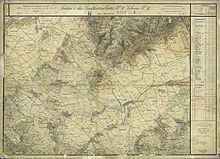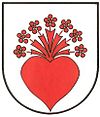Wulkaprodersdorf
|
market community Wulkaprodersdorf
Vulkaprodrštof |
||
|---|---|---|
| coat of arms | Austria map | |
|
|
||
| Basic data | ||
| Country: | Austria | |
| State : | Burgenland | |
| Political District : | Eisenstadt area | |
| License plate : | EU | |
| Surface: | 12.21 km² | |
| Coordinates : | 47 ° 48 ' N , 16 ° 30' E | |
| Height : | 171 m above sea level A. | |
| Residents : | 1,980 (January 1, 2020) | |
| Population density : | 162 inhabitants per km² | |
| Postal code : | 7041 | |
| Community code : | 1 03 19 | |
| NUTS region | AT112 | |
| UN / LOCODE | AT WUL | |
| Address of the municipal administration: |
Obere Hauptstrasse 1 7041 Wulkaprodersdorf |
|
| Website: | ||
| politics | ||
| Mayor : | Friedrich Zarits ( ÖVP ) | |
|
Municipal Council : ( 2017 ) (21 members) |
||
| Location of Wulkaprodersdorf Vulkaprodrštof in the Eisenstadt-Umgebung district |
||
 Parish church Wulkaprodersdorf with fortifications |
||
| Source: Municipal data from Statistics Austria | ||
Wulkaprodersdorf ( Croatian Vulkaprodrštof , Hungarian Vulkapordány ) is a market town with 1980 inhabitants (as of January 1, 2020) in Burgenland in the Eisenstadt-Umgebung district in Austria and is part of the settlement area of the Burgenland-Croatian ethnic group.
geography
The community is located in northern Burgenland near the state capital Eisenstadt . Wulkaprodersdorf is the only place in the municipality.
Wulkaprodersdorf is located in the Wulka Plain, which is bordered in the north by the Leithagebirge , in the west by the Rosaliengebirge and in the east by the Ödenburger Gebirge .
The village got its name from the river Wulka , which rises in the Rosaliengebirge, merges with the Sulzbach and the Hirmerbach in Wulkaprodersdorf and flows through the town south of the main road. As the most important tributary, the Wulka flows into Lake Neusiedl.
The highest point (Föllig) reaches a height of 243 m and even offers a view of Lake Neusiedl. The lowest point (Pieler Mühle) is 162 m. The total area of Wulkaprodersdorf covers 12.22 km.
The favorable climatic zone gives the population of Wulkaprodersdorf a variety of cultivation options. The place is particularly known for its viticulture. Due to the climatic, geological and geographical conditions, it is possible to grow numerous grape varieties.
history
The area around Wulkaprodersdorf was settled as early as the Neolithic Age (5,000 BC). Before the birth of Christ, the area was part of the Celtic Kingdom of Noricum and belonged to the surroundings of the Celtic hill settlement Burg on the Schwarzenbacher Burgberg .
Later under the Romans, today's Wulkaprodersdorf was then in the province of Pannonia . Due to its favorable geographical location, Wulkaprodersdorf is an important traffic junction. In Roman times (born in BC - AD 400) the place was on an important country road (Vicinalstraße). There were Roman manors in several places in the municipality, a Roman cemetery was at the train station, where many Roman graves were destroyed during the construction of the railway in 1879/80.
Wulkaprodersdorf was first mentioned in a document in 1252. The Turkish wars of 1529 and 1532 hit the place so hard that it had to be resettled with Croats. The first Croats settled in Wulkaprodersdorf as early as 1530. From then on there was a permanent increase in Croatian settlers.

Like all of Burgenland, the place belonged to Hungary (German-West Hungary) until 1920/21. Since 1898 had due to the Magyarization of the government in Budapest of Hungarian name Vulkapordány be used. Although "Vulkapordany" belonged to Hungary historically and under constitutional law, the population was linguistically and economically oriented towards Austria.
After the end of the First World War, after tough negotiations, German-West Hungary was awarded to Austria in the Treaties of St. Germain and Trianon in 1919. The place has belonged to the newly founded federal state of Burgenland since 1921 (see also the history of Burgenland ).
Wulkaprodersdorf was one of the first communities in northern Burgenland to have electricity available. After Eisenstadt and Bad Sauerbrunn, some houses in the community could be supplied with electricity. By building a turbine near the Wulka River, it was possible to generate electricity. So it was possible to run an open-air cinema in 1921.
In the interwar period and also during the First World War, the economic situation of the community was very bad. As a result, life in the village only slowly began to return to normal. The most important projects were the construction of the aqueduct and the sewer system.
During the Second World War, many men were called up for war. Not only the loss of a few young men in the village was lamented, but also the workers for the farms were missing. Almost every second house made a living from agriculture. Thus, in 1940 prisoners of war were requested, who then had to work in the factories. Many families whose mother tongue was Croatian lived in Wulkaprodersdorf. It is said that during the war it was not officially forbidden to use the Croatian language, but its use could have serious consequences. The community was repeatedly affected by the war, because in 1944 part of the aircraft factory was moved from Wiener Neustadt to Wulkaprodersdorf.
After the end of the Second World War, the majority of the population voted in a secret ballot in favor of an autonomous German West Hungary.
Today Wulkaprodersdorf is the seat of the Wulkatal water association. In order to prevent the young population in particular from emigrating, new residential complexes were created.
In the course of the celebrations for the 700th anniversary, the municipality of Wulkaprodersdorf was granted the right to use the designation “market municipality” on June 21, 1992.
Population development

Culture and sights
- Parish church Wulkaprodersdorf : The church is from the early baroque period and was consecrated in 1642. The tower was built in 1801.
- Lady Chapel: built in 1779
- Cholera Chapel: built in 1831
- Trinity Column: from 1725
Economy and Infrastructure
Wulkaprodersdorf is a railway junction in Burgenland. Here, the true from the ÖBB -betriebene Leitha mountain railway from Parndorf to Raaberbahn Sopron - Ebenfurth . These routes have connections to Vienna, Eisenstadt, Sopron and Bratislava (via Vienna).
The Hungarian-Austrian Raaberbahn has its Austrian headquarters in Wulkaprodersdorf. The Raaberbahn remotely controls the Sopron – Ebenfurth and Neusiedl am See – Pamhagen route from the Wulkaprodersdorf operations control center .
politics
Municipal council
The council comprises a total of 21 members on the basis of population.
| Political party | 2017 | 2012 | 2007 | 2002 | 1997 | ||||||||||
|---|---|---|---|---|---|---|---|---|---|---|---|---|---|---|---|
| Sti. | % | M. | Sti. | % | M. | Sti. | % | M. | Sti. | % | M. | Sti. | % | M. | |
| ÖVP | 575 | 47.80 | 10 | 454 | 36.09 | 7th | 372 | 29.88 | 6th | 388 | 30.79 | 7th | 346 | 30.67 | 6th |
| SPÖ | 408 | 33.92 | 7th | 520 | 41.34 | 9 | 619 | 49.72 | 11 | 663 | 52.62 | 11 | 580 | 51.42 | 11 |
| UDW A1 | 220 | 18.29 | 4th | 284 | 22.58 | 5 | 229 | 18.39 | 4th | 179 | 14.21 | 3 | 151 | 13.39 | 2 |
| FPÖ | not running | not running | 25th | 2.01 | 0 | 30th | 2.38 | 0 | 51 | 4.52 | 0 | ||||
| Eligible voters | 1589 | 1574 | 1596 | 1548 | 1465 | ||||||||||
| voter turnout | 83.95% | 85.58% | 84.90% | 88.89% | 86.08% | ||||||||||
Parish council
In addition to Mayor Friedrich Zarits (ÖVP) and Vice Mayor René Pint (SPÖ), Birgit Dragschitz (ÖVP), Hans-Peter Gutdeutsch (SPÖ), Andreas Handl (ÖVP), Elisabeth Szuppin (ÖVP) and Sabine Szuppin (UDW) are also members of the municipal board .
mayor
Mayor is Friedrich Zarits (ÖVP). In 2012 he took over the office of Hans Haller (SPÖ), against whom he prevailed in the runoff election with 52.42: 47.58 percent. In the direct mayor election on October 1, 2017, Zarits was confirmed in his office with 52.36% in the first ballot. His two competitors Markus Krojer (SPÖ) and Sabine Szuppin (UDW) did not exceed 32.57% and 15.07% respectively.
In the constituent meeting of the municipal council, René Pint (SPÖ) was elected Vice Mayor.
Personalities
- Stefan Dobrovich (1904–1995), farmer and politician (ÖVP)
- Matthias Semeliker (1910–1986), Roman Catholic pastor, 1943–1945 in Dachau concentration camp
- Hermann Fister (1938-2006), Austrian politician (SPÖ)
- Agidius Zsifkovics (* 1963), Roman Catholic clergyman, Bishop of Eisenstadt
Web links
- 10319 - Wulkaprodersdorf. Community data, Statistics Austria .
- Official community website
Individual evidence
- ↑ a b Results of the 2017 municipal council elections in Wulkaprodersdorf. Office of the Burgenland Provincial Government, October 29, 2017, accessed on January 17, 2020 .
- ^ Election result of the 2012 municipal council election in Wulkaprodersdorf. Office of the Burgenland Provincial Government, November 4, 2012, accessed on January 17, 2020 .
- ^ Election result of the 2007 municipal council election in Wulkaprodersdorf. Office of the Burgenland Provincial Government, October 21, 2007, accessed on January 17, 2020 .
- ↑ a b Results of the local council election 2002 in Wulkaprodersdorf. Office of the Provincial Government of Burgenland, October 21, 2002, accessed on January 17, 2020 .
- ↑ a b Marktgemeinde Wulkaprodersdorf: Municipal Council (accessed on December 20, 2017)
- ^ Province of Burgenland: Shortlisted Mayor Wulkaprodersdorf (accessed December 20, 2017)





